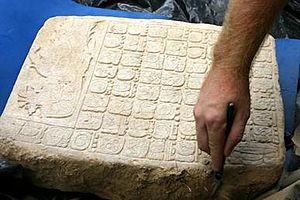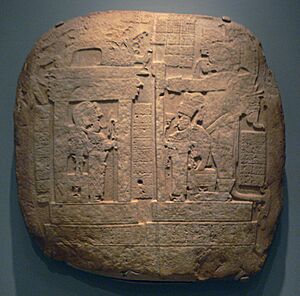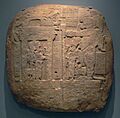La Corona facts for kids
La Corona is an ancient Maya city in Guatemala. It's located deep in the jungle of the Petén region. Archaeologists discovered this important place in 1996. For a long time, experts had been looking for a mysterious site called "Site Q." This "Site Q" was known for its beautiful stone carvings that had been taken illegally from their original home. La Corona was finally identified as this long-lost "Site Q." The ancient Maya name for La Corona seems to have been Sak-Nikte', which means 'White-Flower'.

Contents
The Search for Site Q
In the 1960s, some Maya stone carvings appeared on the international art market. These carvings mentioned a city that no one knew about yet. One carving, showing a ball player, is now in the Art Institute of Chicago. Another is in the Dallas Museum of Art.
Peter Mathews, a student at Yale, called this unknown city "Site Q." The "Q" stood for ¿Qué?, which is Spanish for "what?". Some researchers thought the carvings might be from Calakmul, a very powerful Maya city. But the art style was different from anything found at Calakmul.
In 1996, environmentalists Santiago Billy and Carlos Catalan found the ruins while studying scarlet macaws. The next year, Ian Graham and David Stuart from Harvard University's Peabody Museum of Archaeology and Ethnology explored the site. They named it La Corona. Among the broken sculptures left by people who had stolen artifacts, David Stuart found clues. These clues were names of places and people that matched those on the "Site Q" carvings. This made him believe La Corona was "Site Q."
In 2005, Marcello A. Canuto, a professor from Yale University, found a stone panel still in its original place at La Corona. This panel mentioned two rulers from "Site Q." The stone for the panel came from the same type of rock as the other "Site Q" artifacts. This was strong proof that La Corona was indeed the long-sought "Site Q."

Recent Discoveries at La Corona
Since 2008, the La Corona Archaeological Project (PRALC) has been studying the site. Marcello A. Canuto from Tulane University and Tomás Barrientos from Universidad del Valle de Guatemala lead this project.
In April 2012, the project team made an exciting discovery. They found a row of 12 stone staircase steps with many different carved scenes. They also found 10 more carved steps that had been stolen but then left behind. These discarded steps were too worn down to be sold on the illegal market.
The writings on these newly found panels tell important stories. They give details about political events during the Classic Maya period. One panel even mentions a famous date in Maya history: 4 Ahau 3 K'ank'in. This date marks the end of the 13th baktun, a significant cycle in the Maya calendar.
La Corona's History and Alliances
Much of the research at La Corona focuses on its relationship with the powerful kingdom of Calakmul. Calakmul was one of the biggest Maya cities.
A famous carved panel, now in the Dallas Museum of Art, shows two royal women from Calakmul. They are riding in large, decorated carriers called palanquins. The text on the panel tells us that three women from Calakmul's royal family married kings of La Corona.
For example, in AD 721, a daughter of the Calakmul king, Yuknoom Took' K'awiil, married a king of La Corona. About 40 years earlier, in AD 679, another daughter from Calakmul's powerful king, Yuknoom Ch'een, had also married a La Corona king. A newly found carving mentions another important visit. In 696 AD, another Calakmul king, Yuknoom Yich'aak K'ahk', visited La Corona. This visit happened after Calakmul had been defeated by its rival city, Tikal.
Images for kids
See also
 In Spanish: La Corona (sitio arqueológico) para niños
In Spanish: La Corona (sitio arqueológico) para niños





